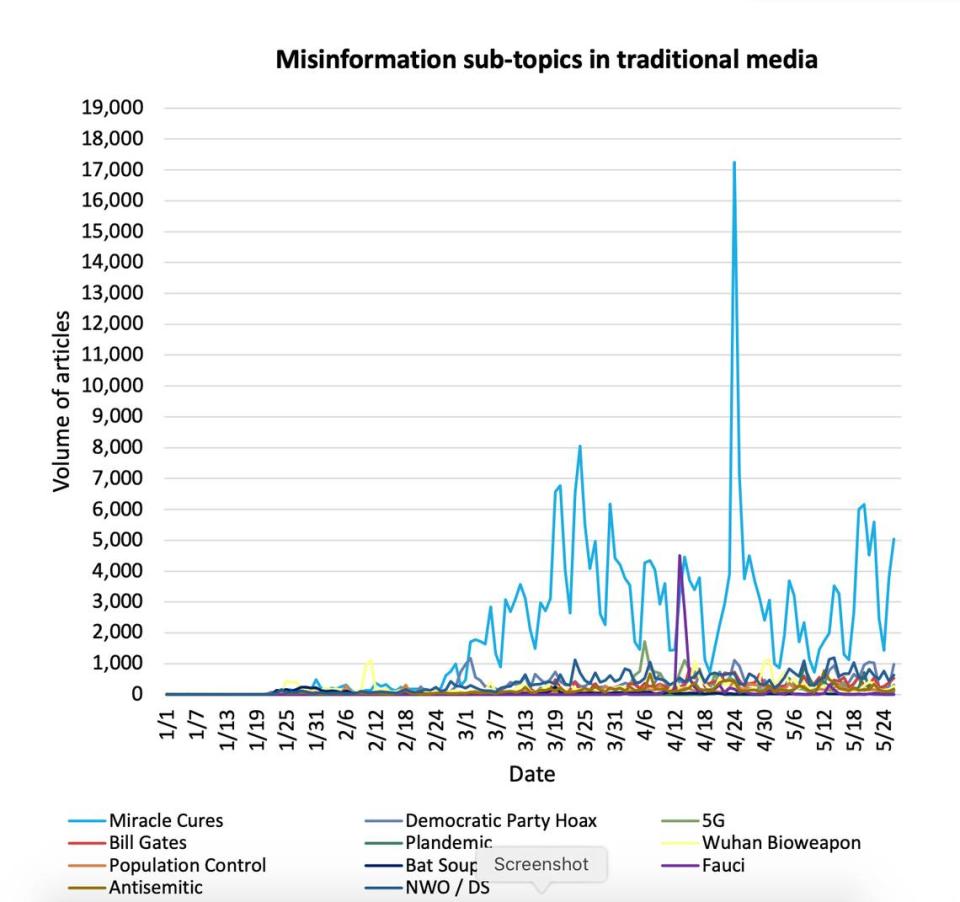Trump is the ‘largest driver of misinformation’ during COVID-19 pandemic, study finds
A review of over 38 million articles about the coronavirus published in English-language media reveals that President Donald Trump was likely the “largest” spreader of misinformation since January when the virus first emerged in Wuhan, China.
Researchers at Cornell University say this “infodemic” has put Americans in danger by giving them reason to go against official health advice such as mask-wearing and social distancing, which can contribute to further viral spread.
What’s more, misinformation about treatments can fuel doubts about the future vaccine and lead people to try unapproved “cures,” as was the case with an Arizona man who died after drinking fish tank cleaner with chloroquine, which Trump explored as a possible coronavirus treatment.
The researchers say their study also highlights the role media professionals play in spreading misinformation, by “amplifying the voices of prominent people, even if those sources are incorrect,” study lead author Sarah Evanega, director of the Cornell Alliance for Science, said in a news release sent to McClatchy News.
The team acknowledges that many media outlets fact-check claims, especially those touted by Trump, but that sometimes the effort goes unnoticed once internet users get their hands on the conspiracy theories.
The study was undergoing peer-review to be published in a social science journal, but it was taking too long, Evanega told McClatchy News in an email. “The pandemic is not patient enough for peer review...so we made the decision to pull it last week to get the information out to the broader media-consuming public whose health is at risk.”
“It is especially notable that while misinformation and conspiracy theories promulgated by ostensibly grassroots sources, such as antivaccination groups, 5G opponents, and political extremists, do appear in our analysis in several of the topics, they contributed far less to the overall volume of misinformation than more powerful actors, in particular the US President,” the researchers wrote in their study.
“These competing narratives and explanations have risen and fallen rapidly, behaving almost as viral phenomena themselves,” they said.
The researchers used a platform to aggregate articles published in English between Jan. 1 and May 26 from the U.S, UK, India, Ireland, Australia, New Zealand and some African and Asian nations.

Of the over 38 million articles found, more than 1.1 million mentioned COVID-19 misinformation, with mentions of Trump and his claims making up nearly 38% of them.
Although the misinformed articles represent just under 3% of the total coverage on coronavirus, articles that included fact-checking comprised “just” 16.4% of the total, “suggesting that the majority of COVID misinformation is conveyed by the media without question or correction.”
Within the misinformation category, the researchers assigned 11 sub-topics including conspiracy theories on “miracle cures,” the “Democratic Party Hoax,” a Wuhan lab that created the virus as a bioweapon, attacks on Dr. Anthony Fauci and population control. Mentions on Trump were included in this category because many of his comments have touched on these subjects.
The most popular topic was what study authors termed “miracle cures.” It appeared in “295,351 articles — more than the other 10 topics combined,” according to the news release.
A spike in news coverage on “miracle cures” jumped significantly around April 24 when Trump mentioned the possibility of “using bleach or other disinfectants internally” to cure coronavirus, as well as his support of hydroxychloroquine as a COVID-19 treatment despite a lack of peer-reviewed clinical data proving its efficacy.

A separate study published in August revealed that conspiracy theories were responsible for nearly 800 deaths, 5,876 hospitalizations, and at least 60 cases of permanent blindness, McClatchy News previously reported.
About 40,400 articles were also found to have spread the idea that the Democratic Party intentionally manufactured the virus to “coincide with” Trump’s impeachment, the study said. Trump’s son, Eric Trump, was the “most prominent public advocate of this idea” when he said in May that the virus will “magically all of a sudden disappear” after the Nov. 3 presidential election.
The Fake News Media and their partner, the Democrat Party, is doing everything within its semi-considerable power (it used to be greater!) to inflame the CoronaVirus situation, far beyond what the facts would warrant. Surgeon General, “The risk is low to the average American.”
— Donald J. Trump (@realDonaldTrump) March 9, 2020
Another prominent spike in misinformation occurred on April 13 when President Trump retweeted a Twitter post that said “Time to #FireFauci,” according to the study. Conspirators accused Fauci, director of the National Institute of Allergy and Infectious Diseases and member of the White House Coronavirus Task Force, of lying about the virus’ danger to benefit from vaccine and drug sales.
However, not all of the articles included in the misinformation category actually spread falsehoods.
“Nearly a third of the media coverage was termed ‘fact-checking’ by study authors because it specifically sought to correct misinformation,” the release said.
The team did not evaluate how misinformation spread on social media, but they did track users’ shares of media articles containing falsities and discovered 36 million “engagements” on social media, with 75% of them happening on Facebook, according to the release.
Twitter and Facebook have since started their own efforts to quash misleading or false information on the coronavirus that began in April by labeling posts that contain misinformation, McClatchy News reported, including those coming from the president.

